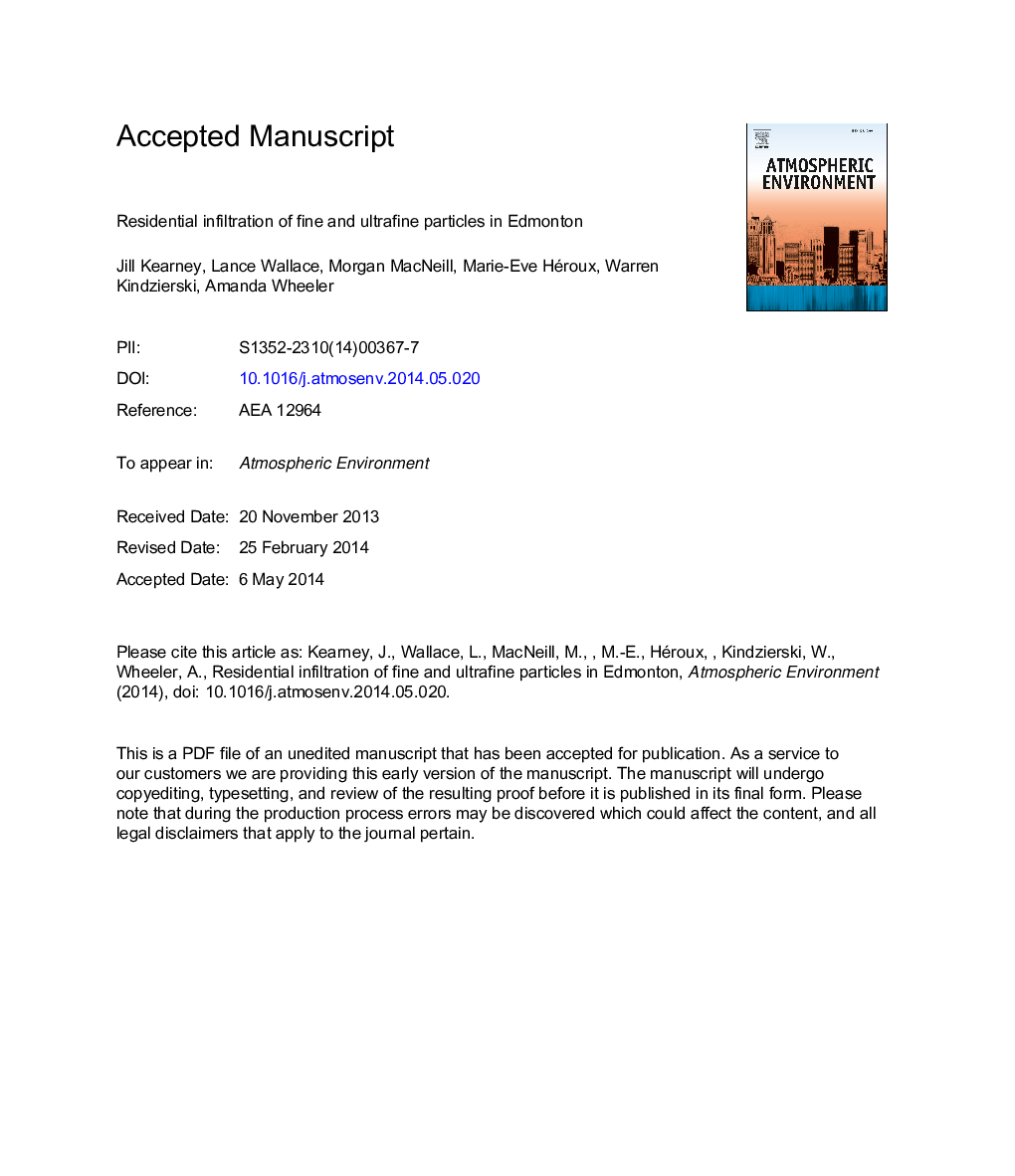| کد مقاله | کد نشریه | سال انتشار | مقاله انگلیسی | نسخه تمام متن |
|---|---|---|---|---|
| 6339722 | 1620377 | 2014 | 44 صفحه PDF | دانلود رایگان |
عنوان انگلیسی مقاله ISI
Residential infiltration of fine and ultrafine particles in Edmonton
ترجمه فارسی عنوان
نفوذ مسکونی ذرات ریز و فوق العاده در ادمونتون
دانلود مقاله + سفارش ترجمه
دانلود مقاله ISI انگلیسی
رایگان برای ایرانیان
کلمات کلیدی
موضوعات مرتبط
مهندسی و علوم پایه
علوم زمین و سیارات
علم هواشناسی
چکیده انگلیسی
Airborne indoor particles arise from both indoor sources and ambient particles that have infiltrated indoors. The intra-urban variability of infiltration factors (Finf) is a source of measurement error in epidemiological studies estimating exposure from a central site measurement, hence information on the within and between-home variability of Finf is useful to better characterize ambient PM exposure. The objective of this paper was to estimate magnitudes and predictors of daily residential infiltration factors (Finf) and ambient/non-ambient components of indoor ultrafine particle (UFP) and fine particle (FP) concentrations. FPs and UFPs were measured continuously for 7 consecutive days in 74 Edmonton homes in winter and summer 2010 (50 homes in each season). Simultaneous measurements of outdoor (near-home) FP and ambient (at a central site) UFP concentrations were also measured. Daily infiltration factors were estimated for each home; considerable variability was seen within and between homes. For FPs, seasonal-averaged Finf (the average of the 7 daily Finf estimates) ranged from 0.10 to 0.92 in winter (median = 0.30, n = 49) and 0.31 to 0.99 in summer (median = 0.68, n = 48). For UFPs, the seasonal-averaged Finf ranged from 0.08 to 0.47 across homes in winter (median = 0.21, n = 33 houses) and from 0.16 to 0.94 in summer (median = 0.57, n = 48). The higher median Finf in summer was attributed to a high frequency of open windows. Daily infiltration factors were also estimated based on the indoor/outdoor PM1 sulfur ratio. These estimates were poorly correlated with DustTrak-based FP infiltration factor estimates; the difference may be due to losses of volatile components on the PM1 filter samples. Generalized linear mixed models were used to identify variables significantly associated with Finf and the non-ambient component of indoor FP and UFP concentrations. Wind speed was consistently associated with Finf across all seasons for both FPs and UFPs. The use of an air cleaner was associated with reduced UFP infiltration factors in summer, suggesting a potential method of reducing infiltrated UFPs. Various cooking activities and smoking were associated with the non-ambient component of indoor FP and UFP concentrations. On average, the majority of indoor FPs were of ambient origin while the majority of UFPs were of indoor origin. In summer, more of the indoor FP and UFP concentrations were from ambient origin, compared to winter, due to the higher infiltration factors. The variability in FP and UFP Finf within and between homes may cause substantial exposure misclassification in epidemiological studies using only ambient measurements.
ناشر
Database: Elsevier - ScienceDirect (ساینس دایرکت)
Journal: Atmospheric Environment - Volume 94, September 2014, Pages 793-805
Journal: Atmospheric Environment - Volume 94, September 2014, Pages 793-805
نویسندگان
Jill Kearney, Lance Wallace, Morgan MacNeill, Marie-Eve Héroux, Warren Kindzierski, Amanda Wheeler,
